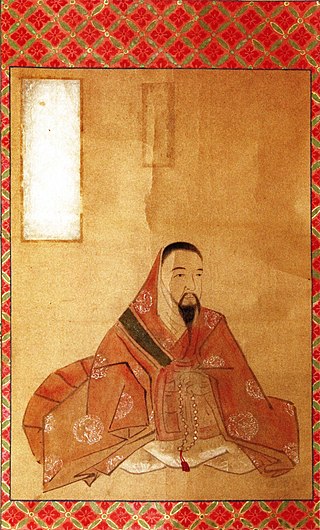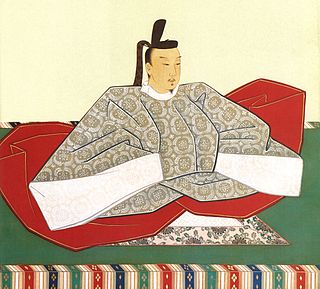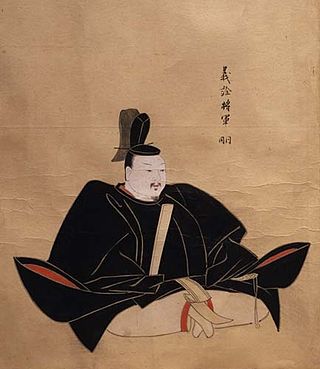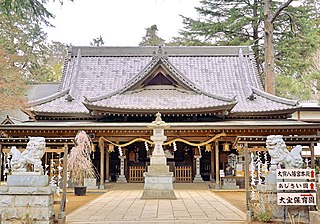
Emperor Sukō was the third of the Emperors of Northern Court during the Period of the Northern and Southern Courts in Japan. According to pre-Meiji scholars, his reign spanned the years from 1348 through 1351.

Emperor Go-Kōgon was the 4th of the Emperors of Northern Court during the Period of the Northern and Southern Courts. According to pre-Meiji scholars, his reign spanned the years from 1352 through 1371.

Emperor Go-En'yū was the 5th of the Emperors of Northern Court during the period of two courts in Japan. According to pre-Meiji scholars, his reign spanned the years from 1371 through 1382.
Year 1392 (MCCCXCII) was a leap year starting on Monday of the Julian calendar.
Emperor Chōkei was the 98th emperor of Japan, according to the traditional order of succession. He reigned from 1368 through 1383. His personal name was Yutanari (寛成) and his regal name roughly translates to "Long Celebration".

Emperor Go-Kameyama was the 99th emperor of Japan, according to the traditional order of succession. He ruled from 1383 to October 21, 1392, becoming the last Emperor of the Southern Court. His personal name was Hironari (熙成).
A royalist supports a particular monarch as head of state for a particular kingdom, or of a particular dynastic claim. In the abstract, this position is royalism. It is distinct from monarchism, which advocates a monarchical system of government, but not necessarily a particular monarch. Most often, the term royalist is applied to a supporter of a current regime or one that has been recently overthrown to form a republic.

Emperor Go-Komatsu was the 100th emperor of Japan, according to the traditional order of succession, and the sixth and final Emperor of the Northern Court.

Emperor Go-Murakami was the 97th emperor of Japan, according to the traditional order of succession, and a member of the Southern Court during the Nanboku-chō period of rival courts. He reigned from September 18, 1339, until March 29, 1368. His personal name was Noriyoshi (義良). He reigned from Sumiyoshi, Ōsaka, Yoshino, Nara, and other temporary locations.

Ashikaga Yoshiakira was the second shōgun of the Ashikaga shogunate who reigned from 1358 to 1367 during the Muromachi period of Japan. Yoshiakira was the son of the founder and first shōgun of the Muromachi shogunate, Ashikaga Takauji. His mother was Akahashi Tōshi (赤橋登子), also known as Hōjō Nariko.

Qi, known in historiography as the Southern Qi or Xiao Qi, was a Chinese imperial dynasty and the second of the four Southern dynasties during the Northern and Southern dynasties era. It followed the Liu Song dynasty and was succeeded by the Liang dynasty. The main polity to its north were the Northern Wei.

The Northern and Southern dynasties in the history of Vietnam, spanning from 1533 to 1592, was a political period in the 16th century during which the Mạc dynasty, established by Mạc Đăng Dung in Đông Đô, and the Revival Lê dynasty based in Tây Đô were in contention. For most of the period, these two dynasties fought a lengthy war known as the Lê–Mạc War.

The Genkō War, also known as the Genkō Incident, was a civil war fought in Japan between the Emperor Go-Daigo and the Kamakura Shogunate from 1331 to 1333. The Genkō War was named after Genkō, the Japanese era corresponding to the period of 1331 to 1334 when the war occurred.
The 1353 battle of Yawata was a battle of the Nanboku-chō period of Japanese history, and took place in Yawata, Japan. It was fought in January 1353 between the armies of the Northern and Southern Emperors of Japan, as the loyalists sought to obtain a base of operations just outside the capital from which they could launch attacks on Kyoto. The army of the Southern Court was led by Moroushi, who secured the town for the loyalists; a successful siege was launched upon Kyoto the following year.

Jōwa (貞和) was a Japanese era or nengō which was promulgated by the more militarily powerful of two Imperial rival courts during the Era of Northern and Southern Courts. This nengō came after Kōei and before Kannō and lasted from October 1345 through February 1350. The emperor in Kyoto was Emperor Kōmyō. Go-Kōgon's Southern Court rival in Yoshino during this time-frame was Emperor Go-Murakami.

Emperor Kōgon was the first of the Emperors of Northern Court during the Period of the Northern and Southern Courts in Japan. His reign spanned the years from 1331 through 1333.

Ashikaga Yoshimitsu was the third shōgun of the Ashikaga shogunate, ruling from 1368 to 1394 during the Muromachi period of Japan. Yoshimitsu was Ashikaga Yoshiakira's third son but the oldest son to survive, his childhood name being Haruō (春王). Yoshimitsu was appointed shōgun, a hereditary title as head of the military estate, in 1368 at the age of ten; at twenty he was admitted to the imperial court as Acting Grand Counselor.
Tōin Kinkata was a member of the Court during the late Kamakura period and early Nanboku-chō period in Japanese history. As a writer, Kinkata was the author of the diary Entairyaku (園太暦),where he reviewed the events of the imperial court in 1311 and between 1344 and 1360.

Uzumine (宇津峰) was a Nanboku-chō period Yamashiro-style Japanese castle located on Mount Uzumine, a mountain with an altitude of 677 metres (2,221 ft), at the border between the cities of Kōriyama and Sukagawa in Fukushima Prefecture, Japan. The castle was also known as "Hoshiga-jō" (星が城) of "Unsui-mine" (雲水峯). The site was designated a National Historic Site of Japan in 1951.

Daihō Castle was a hirayama-style Muromachi period Japanese castle located in what is now the city of Shimotsuma, Ibaraki Prefecture, in the northern Kantō region of Japan. Its ruins have been protected as a National Historic Site since 1934.














